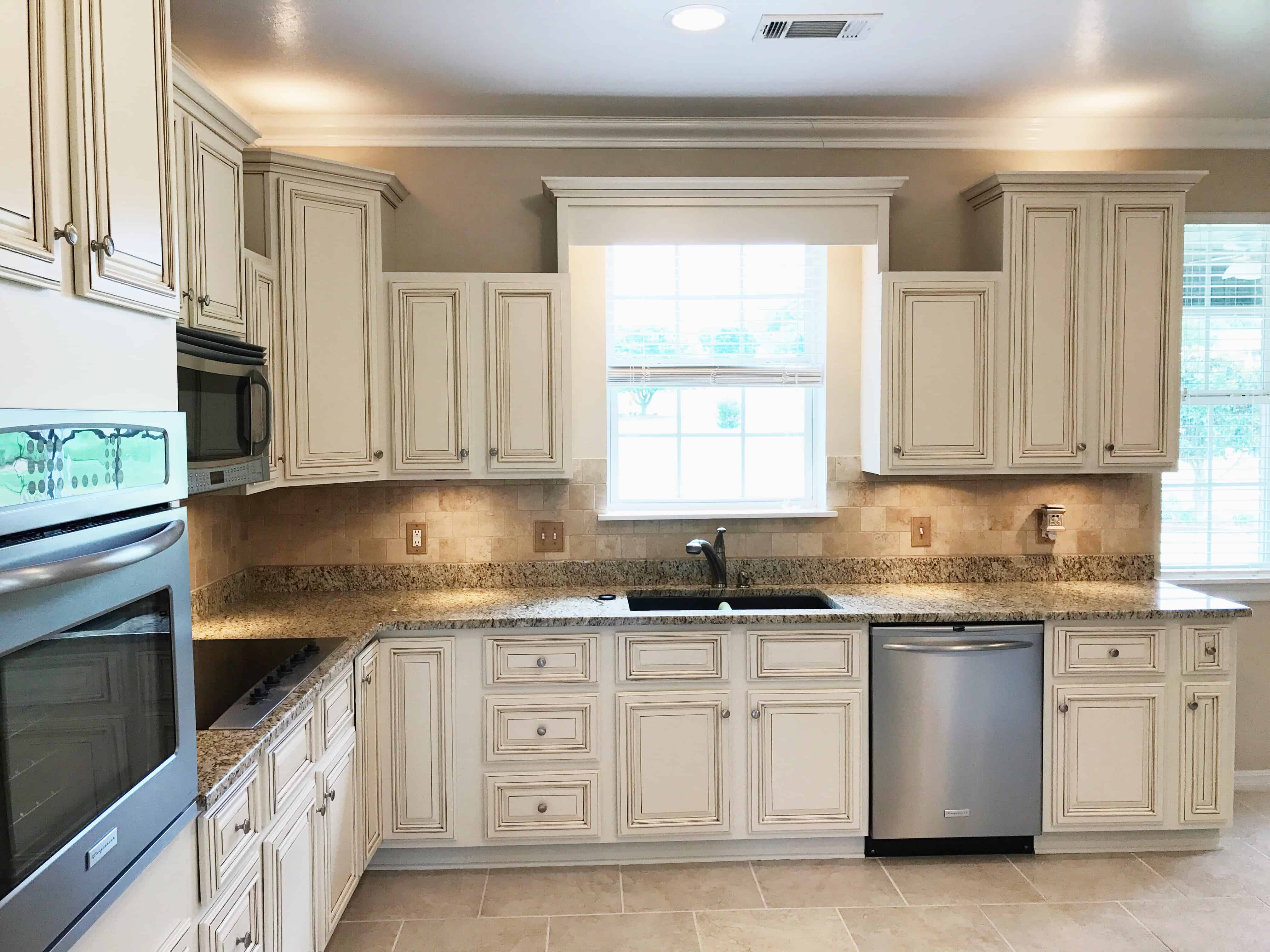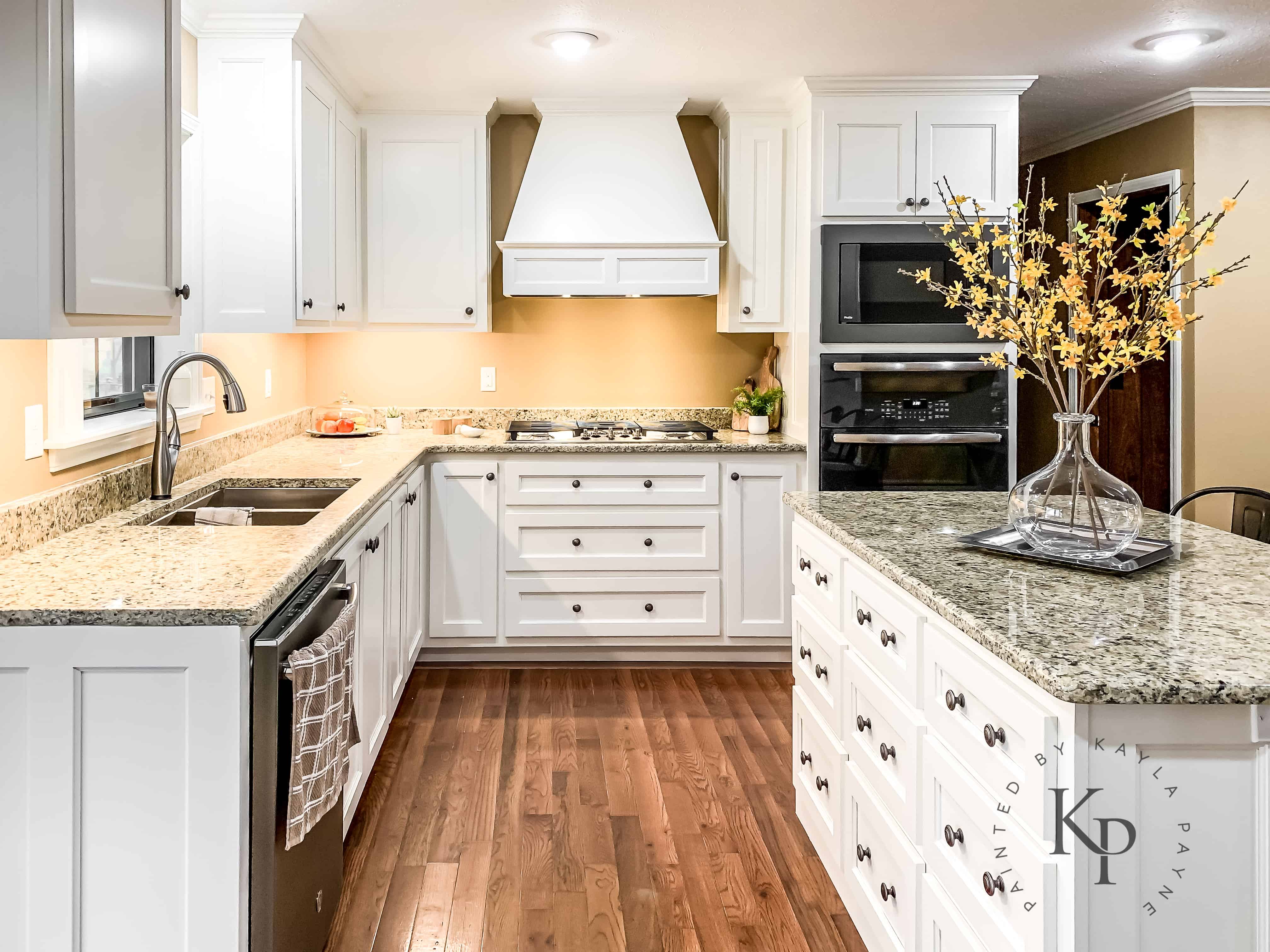Visual Appeal and Design Considerations for Off-White Cabinets with White Trim
Off-white cabinets paired with crisp white trim offer a versatile and timeless aesthetic, adaptable to various design styles. The subtle contrast creates a clean and sophisticated look that can be customized through careful selection of countertops, backsplashes, and lighting.
Aesthetic Impact Across Different Room Styles
The combination of off-white cabinets and white trim lends itself well to several popular design aesthetics. In modern kitchens, the clean lines and minimalist feel of this color scheme create a sense of spaciousness and order. The off-white softens the starkness of pure white, preventing the space from feeling cold or sterile. A traditional kitchen benefits from the classic elegance this pairing evokes. The off-white cabinets offer a warm counterpoint to the bright white trim, creating a balanced and inviting atmosphere. Farmhouse kitchens can embrace the rustic charm by incorporating natural wood elements and vintage hardware, with the off-white and white palette providing a neutral backdrop that enhances the overall style.
Countertop Material Selection
Choosing the right countertop material is crucial for complementing the off-white cabinets and white trim. The countertop should not only enhance the visual appeal but also offer practicality in terms of durability and maintenance. Here are three popular options:
| Countertop Material | Cost (Approximate Range) | Maintenance | Visual Impact |
|---|---|---|---|
| Quartz | $$$ (High) | Low maintenance; resistant to stains and scratches. | Offers a sleek, modern look with a wide range of colors and patterns available to complement the off-white cabinets and white trim. Can mimic the look of natural stone without the high maintenance. |
| Granite | $$ (Medium-High) | Requires regular sealing to prevent staining; susceptible to etching from acidic substances. | Provides a classic, luxurious look with unique veining and color variations. The natural variations can add visual interest and depth to the kitchen. |
| Laminate | $ (Low) | Easy to clean and maintain; less durable than natural stone or quartz. | Offers a budget-friendly option with a wide variety of colors and patterns. While less durable, it can effectively complement the off-white and white scheme. |
Lighting Strategies for Optimal Visual Effect
Proper lighting is essential to highlight the beauty of off-white cabinets and white trim. Natural light should be maximized whenever possible, as it enhances the warmth and brightness of the off-white. Strategically placed windows or skylights can dramatically improve the overall ambiance. Artificial lighting should complement natural light, providing sufficient illumination without casting harsh shadows. Consider a combination of ambient, task, and accent lighting. Recessed lighting can provide even illumination across the kitchen, while under-cabinet lighting can highlight countertops and workspaces. Pendant lights over an island can create a focal point and add visual interest.
Backsplash Design Options
The backsplash offers an opportunity to add personality and visual interest to the kitchen while maintaining harmony with the off-white cabinets and white trim. Here are three different backsplash design options:
Off white cabinets with white trim – Option 1: Subtle Textured Tile
- Material: Small, off-white ceramic tiles with a subtle texture.
- Pattern: Simple, linear pattern or a subtle mosaic.
- Color: Variations of off-white and cream, maintaining a cohesive palette.
Option 2: Classic Subway Tile
- Material: White subway tiles with a glossy finish.
- Pattern: Classic horizontal or vertical subway tile layout.
- Color: Pure white, creating a clean and crisp contrast against the off-white cabinets.
Option 3: Natural Stone Mosaic
- Material: A mosaic of natural stone tiles, such as marble or travertine.
- Pattern: Random or linear pattern, depending on the desired level of visual interest.
- Color: Neutral tones with hints of beige, gray, or cream to complement the off-white cabinets.
Practical Aspects and Maintenance of Off-White Cabinets with White Trim

Choosing off-white cabinets instead of pure white offers a subtle yet impactful design shift. This section delves into the practical considerations and maintenance routines associated with this popular color choice, comparing it to pure white and exploring the durability of various cabinet materials.
Off-White vs. Pure White Cabinets: Advantages and Disadvantages
Off-white cabinets offer a warmer, more forgiving alternative to stark white. While pure white cabinets create a bright, airy feel, they tend to show dirt, smudges, and scratches more readily. Off-white, conversely, camouflages minor imperfections better, resulting in less frequent cleaning needs. However, choosing the right shade of off-white is crucial; some shades may appear dingy or yellow over time, requiring more vigilant maintenance. The perceived level of cleanliness also differs; even with similar levels of actual cleanliness, pure white might appear cleaner due to its higher reflectivity.
Cleaning and Maintaining Off-White Cabinets and White Trim
Regular cleaning is essential to maintain the beauty and longevity of off-white cabinets and white trim. The following steps provide a practical cleaning regimen:
- Dust regularly: Use a soft microfiber cloth or duster to remove dust and loose debris at least once a week. This prevents the accumulation of grime that can be harder to remove later.
- Wipe spills immediately: Promptly clean up any spills to prevent staining. A damp cloth with mild dish soap is usually sufficient.
- Deep clean monthly: Use a mixture of warm water and a mild dish soap or a specialized cabinet cleaner. Apply the solution with a soft sponge or cloth, rinse thoroughly, and dry with a clean microfiber cloth. Avoid abrasive cleaners or scouring pads, as they can scratch the surface.
- Address stubborn stains: For persistent stains, try a baking soda paste (baking soda mixed with water) applied gently with a soft cloth. For grease, a degreaser designed for kitchen use can be effective, but always test it in an inconspicuous area first.
- Protect from moisture: Ensure proper ventilation in your kitchen to prevent moisture buildup, which can lead to warping or mold growth. Use a dehumidifier if necessary.
- Polish regularly: Periodically polish your cabinets with a furniture polish specifically designed for your cabinet material to enhance their shine and protect against minor scratches.
Cabinet Material Durability Comparison
The choice of cabinet material significantly impacts durability, cost, and maintenance. The following table compares common materials:
| Material | Durability | Cost | Maintenance |
|---|---|---|---|
| Wood (Solid) | High; resistant to scratches and stains with proper finish | High | Regular polishing and occasional refinishing may be needed. |
| Laminate | Moderate; susceptible to chipping and scratches, especially at edges | Medium | Easy to clean; avoid abrasive cleaners. |
| Thermofoil | Moderate; less resistant to scratches than wood but more durable than laminate | Medium-High | Easy to clean; avoid harsh chemicals. |
Maintaining Color Consistency of Off-White Cabinets, Off white cabinets with white trim
Off-white cabinets can be prone to discoloration over time due to sun exposure, heat, and cleaning products. To minimize this, avoid placing cabinets in direct sunlight and use UV-protective window film if necessary. Regular cleaning with appropriate products, as Artikeld above, helps prevent discoloration. For minor discoloration, a gentle cleaning and polishing may suffice. For more significant issues, professional refinishing may be required. Consider using consistent cleaning products to avoid uneven fading or discoloration.
Creative Applications and Styling Ideas for Off-White Cabinets with White Trim: Off White Cabinets With White Trim

Off-white cabinets paired with crisp white trim offer a versatile foundation for a multitude of kitchen design styles. The subtle warmth of the off-white complements the clean lines of the white trim, creating a backdrop that can be customized to reflect personal preferences and desired aesthetic. Exploring various design elements allows for the creation of unique and stylish kitchens.
Three Kitchen Designs Featuring Off-White Cabinets and White Trim
The combination of off-white cabinets and white trim provides a neutral canvas upon which diverse design styles can be built. Below are three distinct kitchen designs showcasing the versatility of this color palette.
Minimalist Kitchen
This design prioritizes clean lines, functionality, and a sense of spaciousness. Off-white shaker-style cabinets are paired with sleek white trim, creating a seamless, uncluttered look. The flooring is a light gray porcelain tile, mirroring the minimalist aesthetic. Simple, brushed nickel bar pulls add a touch of modern elegance without detracting from the overall minimalist feel. Recessed lighting provides even illumination, while a single pendant light above the island adds a subtle focal point. The countertops are a seamless quartz in a light gray tone, matching the flooring.
Rustic Kitchen
This design embraces natural materials and a sense of warmth. Off-white cabinets with a slightly distressed finish are complemented by white trim with a slightly raised profile, adding a touch of traditional character. The flooring is wide-plank light oak, adding a rustic touch. Black iron hardware adds a touch of contrast and complements the warm tones of the wood. Warm-toned pendant lighting over the island creates a cozy atmosphere, while under-cabinet lighting illuminates the countertops. Butcher block countertops complete the rustic aesthetic.
Eclectic Kitchen
This design blends various styles and elements for a unique and personalized look. Off-white cabinets in a mix of styles—some shaker, some with glass-front doors—are combined with white trim. The flooring is a patterned cement tile, introducing visual interest and character. A mix of hardware finishes—polished brass pulls on some cabinets and brushed nickel knobs on others—adds a playful, eclectic touch. A combination of recessed and track lighting provides ample illumination, while a vintage-style pendant light over the island serves as a statement piece. The countertops are a mix of materials, perhaps quartz on the main run and a marble backsplash.
Impact of Different Hardware Finishes
The choice of hardware significantly impacts the overall aesthetic of off-white cabinets and white trim.
Different hardware finishes can dramatically change the perceived style of a kitchen. Brushed nickel offers a modern and understated look, complementing a minimalist or contemporary style. Polished brass introduces warmth and a touch of vintage elegance, suitable for transitional or traditional designs. Black hardware provides a striking contrast, adding a bold and sophisticated element to a modern or eclectic kitchen. The choice ultimately depends on the desired overall feel and style.
Incorporating Texture into the Design
Texture adds depth and visual interest to any kitchen design.
- Textured Backsplash: A backsplash with a textured surface, such as a stone tile with a rough or uneven finish, adds visual interest and contrasts with the smooth surfaces of the cabinets and trim. This creates a tactile element that adds to the overall appeal.
- Woven Rugs: Incorporating woven rugs in natural fibers like jute or sisal adds a tactile element to the floor and complements the warmth of off-white cabinets. The texture of the rug softens the overall look and introduces a natural element.
- Wood Countertops: The natural grain and texture of wood countertops, such as butcher block or reclaimed wood, add warmth and visual interest, contrasting beautifully with the smooth off-white cabinets and crisp white trim. This introduces a significant tactile element.
A Designer’s Perspective on AI and Kitchen Design
The creation of truly compelling kitchen designs requires more than just algorithmic outputs. While AI tools can assist with certain aspects of the design process, they cannot replace the creative vision, nuanced understanding of materials, and practical experience of a human designer. A successful kitchen design is built on original thought, informed by years of experience working with clients, materials, and construction techniques. The subtle interplay of color, texture, and form—the very essence of good design—cannot be replicated by algorithms alone. Each design should be a unique reflection of the client’s personality and lifestyle, something that only a human designer can truly achieve. The value lies not in speed and efficiency, but in the crafting of a space that resonates with the client on a deeper level—a space that is more than just the sum of its parts.
